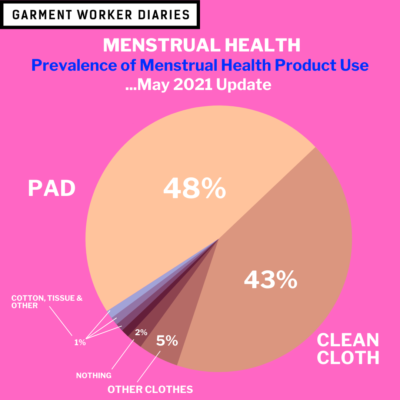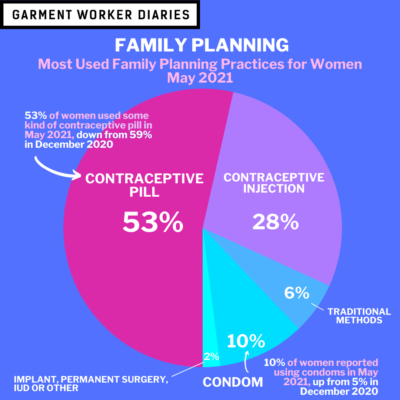This past May 28th was Menstrual Hygiene Day, and on that same day, in collaboration with SNV Bangladesh, we asked female garment workers about their menstrual health. The survey also consisted of questions about practices related to family planning, which include male responses. We pose the survey to workers periodically: our last two surveys were conducted in December and September 2020.
We asked Farhtheeba Rahat Khan (SNV Bangladesh’s Team Leader for RMG Inclusive Business Programs) to give us her perspective on the importance of menstrual hygiene awareness. Her assessment demonstrates well how both workers and factories can benefit when good menstrual health is nurtured and encouraged. Here’s what she had to say:
“Women employed in the garment sector fall mostly within the reproductive age range. Hence, ensuring access to family planning and menstrual hygiene within factory premises is quite crucial. In factories where SNV’s interventions are running, there has been a significant increase in sanitary napkin/pad users: from a share of 49.7% in our baseline survey in 2018 to an 81.9% share in our most recent annual survey from last year. Similarly, the share of cloth users has decreased, from 49.2% to 17.2%. Factories have seen a decline in worker absenteeism and worker leave since the start of intervention.”
With the importance of female health in mind, let’s see what the data are telling us.
Note: Banner photo courtesy of a garment worker in Bangladesh; numbers in graphs may not sum to 100% due to rounding
Menstrual Health and Family Planning
In order to ensure respondent comfort, we only presented menstrual health and family planning survey questions when the respondent and enumerator were of the same gender. This does mean that we were able to ask some men in the study about their use of family planning. However, there was not a sufficient amount of men who were asked these questions to conduct data analysis on male responses.
As it stood in late May 2021, 94% of respondents in the study who were women were partnered with an enumerator who was also a woman, and 99% of those respondents said they felt comfortable enough to answer the questions (the same proportion as in December and September 2020).
Menstrual Health
There was little change in the share of menstrual health products used from September 2020 through May 2021. However, there has been an overall slight decline in the use of clean cloth and a slight increase in the use of pads.
Among those female respondents for whom access to pads was relevant, 81% said they had no trouble accessing pads over the past month (a small percentage of respondents didn’t feel comfortable telling us about their access to pads). For those 18% of garment workers who’d had trouble accessing a pad in the past month, just under half of them said that the reason they’d had trouble was because pads are too expensive.
In all, 10% of female workers in May 2021 told us that they do not menstruate, and 4% told us they do not menstruate due to contraception. Among the remaining women for whom menstruation was relevant, below is the full breakdown of the share of menstrual health product use from September 2020 to May 2021:
|
Menstrual Health Product |
Share Using, September 2020 |
Share Using, December 2020 |
Share Using, May 2021 |
|
Clean cloth |
50% |
48% |
43% |
|
Pad |
38% |
42% |
48% |
|
Garments or other clothes |
4% |
4% |
5% |
|
Nothing |
3% |
1% |
2% |
|
Toilet tissue |
2% |
2% |
1% |
|
Other |
2% |
1% |
1% |
|
Cotton |
1% |
1% |
1% |
Family Planning
Among those female garment workers for whom family planning was relevant, 71% reported employing family planning practices in May 2021, up from 66% in December 2020 and identical to the 71% who said they practice family planning in September 2020. Below is the full breakdown of different methods employed by women from September 2020 to May 2021—there has not been much change over the past nine months, other than the use of a pill has risen and fallen, and the use of condoms has alternatively dipped and then risen again:
|
Family Planning Method |
Share Using, September 2020 |
Share Using, December 2020 |
Share Using, May 2021 |
|
Pill |
52% |
59% |
53% |
|
Injection |
30% |
27% |
28% |
|
Condom |
9% |
5% |
10% |
|
Traditional methods |
7% |
7% |
6% |
|
Implant |
1% |
1% |
1% |
|
Permanent surgery |
<1% |
0% |
1% |
|
IUD |
1% |
<1% |
<1% |
|
Other |
0% |
<1% |
<1% |
|
Not comfortable with question |
<1% |
1% |
<1% |
Among those respondents who practiced family planning, less than 1% said they had trouble purchasing or accessing family planning tools in the past three months (identical to the response rates we received in December and September 2020).
The family planning and menstrual health data come from a pool of 886 female workers in September 2020, 901 workers in December 2020, and 928 workers in May 2021, of whom 875, 895 and 918 workers, respectively, indicated their comfort with answering the questions. These workers are employed in factories spread across the five main industrial areas of Bangladesh (Chittagong, Dhaka City, Gazipur, Narayanganj, and Savar). Just over three-quarters of the garment workers in our entire respondent pool are women, roughly representative of workers in the sector as a whole.


